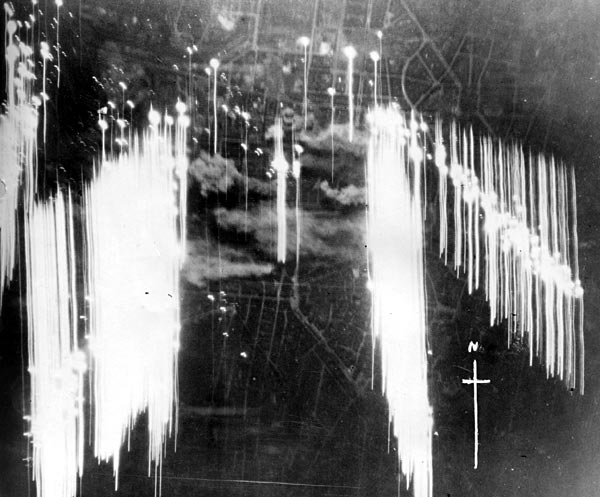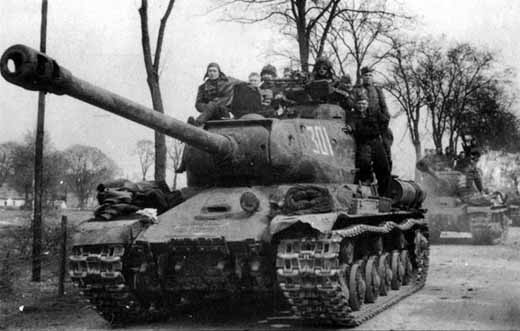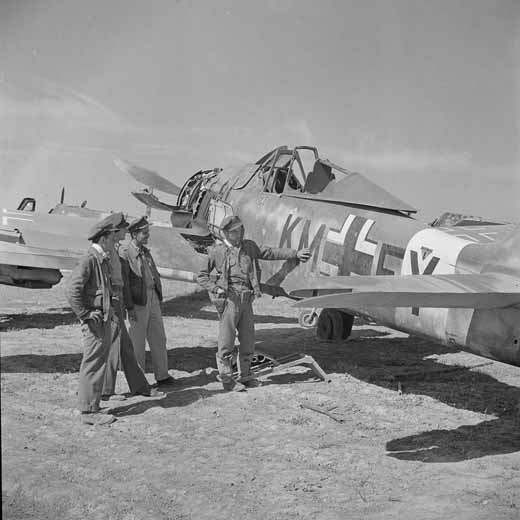Air Operations, Aleutians
- All aircraft sent to attack Kiska abort in the face of bad weather, but several 11th Air Force aircraft attack various targets at Attu.
- The 28th Composite Groupís 36th Bomb Squadron mounts its first operational missions from the airfield at Amchitka.
Air Operations, Bismarcks
90th Heavy Bomb Group B-24s mount individual attacks against barges off New Britain.
[Air Operations, CBI
CHINA- In their unitís combat debut, 18 308th Heavy Bomb Group B-24s attack an airfield, an oil refinery, a coal yard, and docks at Hainan Islandís Samah Bay. 1 damaged B-24 is abandoned during the return flight across French Indochina at the cost of 1 crewman killed.
- 12 11th Medium Bomb Squadron B-25s (crewed with Chinese Air Force co-pilots) attack the port area at Haiphong. Following the bombing attack, 19 23Rd Fighter Group P-40 escorts strafe the port area.
Air Operations, Europe
P-47s escort B-17s during a raid on an automobile factory in Antwerp.
BOMBER COMMANDDaylight Ops:
- 12 Venturas attack the railway yards at Abbeville. 3 Mosquitos out of 6 sent bomb the power stations at Haarlem ant The Hague.
- There are no losses.
- 596 aircraft are sent on the first major raid on Dortmund. Included in this total are 255 Lancasters, 141 Halifaxes, 110 Wellingtons, 80 Stirlings and 10 Mosquitos.
- The initial Pathfinder marking is accurate, but some of the backing-up marking falls short. A decoy fire site also attracts many bombs. Regardless, half the bomb force do bomb within 3 miles of the aiming point. Severe damage is caused in the central and northern parts of Dortmund.
- 12 Halifaxes, 7 Stirlings, 6 Lancasters and 6 Wellingtons are lost. 7 more planes crash in bad weather upon their return to the bomber bases.
BELGIUM:
- 61 of 79 VIII Bomber Command B-17s attack Antwerp industrial areas with 161 tons of bombs.
- No bombers are lost, 16 are damaged; 3 cremen are sounded
- NATBF A-20s and B-25s attack ground targets around Zaghoun in support of a ground attack by Free French ground units.
- NATAF fighters attack gun positions and motor vehicles near Massicault and Zaghoun, the Zaghoun landing ground and road traffic between Zaghoun and Bou Ficha.
- IX Fighter Command P-40 fighter-bombers attack ground targets around Zaghoun.
- East-bound Convoy ONS-5, protected by 18 escorts, is threatened by 60 U-boats in 4 groups. During a battle which extends over 3 nights, 13 merchantmen are lost and 1 is damaged, but the escorts sink 6 U-boats and badly damage 4 more. Another 2 collide and are lost. This result is achieved without the normal level of air support. The US freighter West Maximus (5561t) is torpedoed and sunk by U-264 with the loss of 6. Survivors are rescued by the British trawler Northern Spray.
- U-439 and U-659 are both pursuing two southbound convoys headed for the Mediterranean. One convoy is composed to 15 MTBs and is being shadowed by U-439. U-659 is following a convoy consisting of landing craft. The two submarines did not know the position of each other. U-439 is traveling at 7kts when she is struck by U-659 traveling at 15kts. Water flooded in through the gash of U-659 and moments later, she went to the bottom. At the same time U-439 began sinking by the bow because of the damage sustained in the collision.
- U-630 is sunk in an attack by a Canso of No 5 Squadron RCAF.
- The US submarine Gudgeon (SS-212) sinks the Japanese merchant trawler Naku Maru west of Panay, Philippines.
- The US submarine Seal (SS-183) attacks a Japanese convoy sinking the fleet tanker San Clemente Maru (7354t) about 50 miles southeast of Palau.
ITALY:
IX Bomber Command B-24s attack shipping at Reggio di Calabria and Taranto.
First Attack on Dortmund |
 |
Air Operations, New Guinea
90th Heavy Bomb Group B-24s attack Babo and Wewak.
[Air Operations, Solomons
USN fighters and dive-bombers, and USAAF fighters attack Vangavanga.
[Air Operations, Tunisia
Aleutians
After a day's delay due to bad weather, the convoy sails for the landing on Attu. Strong unfavorable winds on the voyage make it necessary to put back Day X by three more days, i.e. to May 11.
[Battle of the Atlantic
|
|
| Class | Type VIIC |
| CO | Oberleutnant zur See Werner Winkler |
| Location | N Atlantic, NE of Cape Race |
| Cause | Air attack |
| Casualties | 47 |
| Survivors | None |
CBI
BURMAThe Japanese, with their technique of infiltrating in small groups, have now infiltrated between Buthidaung and Maungdaw, disrupting British communications. The British attacks to dislodge them are easily repulsed.
CHINAThe Japanese advance south of the Yangtze River.
[China
The Japanese advance south of the Yangtze River.
[Eastern Front
Hitler postpones the launching of Operation ZITADELLE (CITADEL) from May 9 to mid-June.
Tanks Moving Up for the Operation |
 |
The air war intensifies as the Soviets launch a large raid upon the German railway yards at Orsha. A lucky strike by one aircraft hits an ammunition train, the resulting explosions destroying the surrounding area and more than 300 freight wagons.
[Germany, Strategy
Hitler decides to delay Operation CITADEL to June 13 so that more Tiger and the new Panther tanks can take part in the coming offensive.
[North Africa
TUNISIAThe Germans put up a more stubborn defense that ever on the defensive line at Mateur.
The US II Corps pushes forward in preparation for its full-scale drive on Bizerte on the 6th. On the northern flank, the 9th Div and the Corps Franc d'Afrique get into position for the advance on Bizerte over the hills north of Garaet Achkel. The Corps d'Afrique improves its positions west of Djebel Cheniti, the commanding ridge just north of Gararet Achkel. To the right, the 1st Armored Div, whose next objective is Ferryville, patrols actively from Mateur. The enemy is subjecting Mateur to heavy air attacks. The 91st Reconnaissance Squadron begins a limited offensive for Djebel Achkel, a precipitous hill just south of Garaet Achkel commanding the Mateur-Ferryville area, and meets strong opposition. On the southern flank of the II Corps, the 34th Div patrols uneventfully to Eddekhila in preparation fo the attack on the Chouïgui Pass.
Damaged Focke-Wulf Fw-190 |
 |